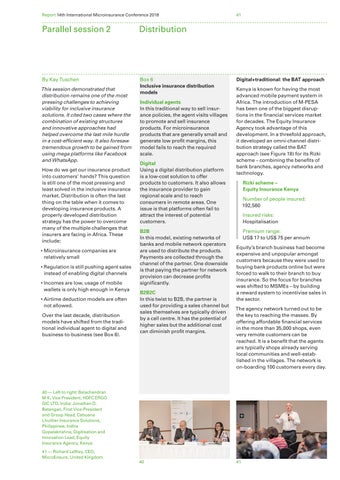Report 14th International Microinsurance Conference 2018
Parallel session 2
Distribution
By Kay Tuschen
Box 6 Inclusive insurance distribution models
This session demonstrated that distribution remains one of the most pressing challenges to achieving viability for inclusive insurance solutions. It cited two cases where the combination of existing structures and innovative approaches had helped overcome the last mile hurdle in a cost-efficient way. It also foresaw tremendous growth to be gained from using mega platforms like Facebook and WhatsApp. How do we get our insurance product into customers’ hands? This question is still one of the most pressing and least solved in the inclusive insurance market. Distribution is often the last thing on the table when it comes to developing insurance products. A properly developed distribution strategy has the power to overcome many of the multiple challenges that insurers are facing in Africa. These include: • Microinsurance companies are relatively small • Regulation is still pushing agent sales instead of enabling digital channels • Incomes are low, usage of mobile wallets is only high enough in Kenya • Airtime deduction models are often not allowed. Over the last decade, distribution models have shifted from the traditional individual agent to digital and business-to-business (see Box 6).
Individual agents In this traditional way to sell insurance policies, the agent visits villages to promote and sell insurance products. For microinsurance products that are generally small and generate low profit margins, this model fails to reach the required scale. Digital Using a digital distribution platform is a low-cost solution to offer products to customers. It also allows the insurance provider to gain regional scale and to reach consumers in remote areas. One issue is that platforms often fail to attract the interest of potential customers. B2B In this model, existing networks of banks and mobile network operators are used to distribute the products. Payments are collected through the channel of the partner. One downside is that paying the partner for network provision can decrease profits significantly. B2B2C In this twist to B2B, the partner is used for providing a sales channel but sales themselves are typically driven by a call centre. It has the potential of higher sales but the additional cost can diminish profit margins.
41
Digital+traditional: the BAT approach Kenya is known for having the most advanced mobile payment system in Africa. The introduction of M-PESA has been one of the biggest disruptions in the financial services market for decades. The Equity Insurance Agency took advantage of this development. In a threefold approach, it developed an omni-channel distribution strategy called the BAT approach (see Figure 18) for its Rizki scheme – combining the benefits of bank branches, agency networks and technology. Rizki scheme – Equity Insurance Kenya Number of people insured: 192,560 Insured risks: Hospitalisation Premium range: US$ 17 to US$ 75 per annum Equity’s branch business had become expensive and unpopular amongst customers because they were used to buying bank products online but were forced to walk to their branch to buy insurance. So the focus for branches was shifted to MSMEs – by building a reward system to incentivise sales in the sector. The agency network turned out to be the key to reaching the masses. By offering affordable financial services in the more than 35,000 shops, even very remote customers can be reached. It is a benefit that the agents are typically shops already serving local communities and well-established in the villages. The network is on-boarding 100 customers every day.
40 — Left to right: Balachandran M K, Vice President, HDFC ERGO GIC LTD, India; Jonathan D. Batangan, First Vice-President and Group Head, Cebuana Lhuillier Insurance Solutions, Philippines; Indira Gopalakrishna, Digitisation and Innovation Lead, Equity Insurance Agency, Kenya 41 — Richard Leftley, CEO, MicroEnsure, United Kingdom
40
41
